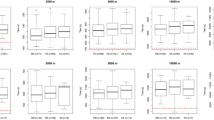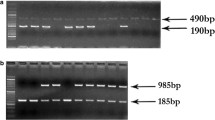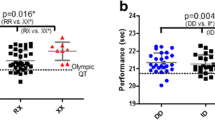Abstract
We have previously demonstrated that, ACE D allele may be related with a better performance in short duration aerobic endurance in a homogeneous cohort with similar training backgrounds. We aimed to study the variation in the short-duration aerobic performance development amongst ACE genotypes in response to identical training programs in homogeneous populations. The study group consisted of 186 male Caucasian non-elite Turkish army recruits. All subjects had undergone an identical training program with double training session per day and 6 days a week for 6 months. Performances for middle distance runs (2,400 m) were evaluated on an athletics track before and after the training period. ACE gene polymorphisms were studied by PCR analysis. The distribution of genotypes in the whole group was 16.7% II, n = 31; 46.2% ID, n = 86; 37.1% DD, n = 69. Subjects with ACE DD genotype had significantly higher enhancement than the ID (P < 0.01) and II (P < 0.05) genotype groups. Around 2,400 m performance enhancement ratios showed a linear trend as ACE DD > ACE ID > ACE II (P value for Pearson χ2 = 0.461 and P value for linear by linear association = 0.001). ACE DD genotype seems to have an advantage in development in short-duration aerobic performance. This data in unison with the data that we have obtained from homogenous cohorts previously is considered as an existence of threshold for initiation of ACE I allele effectiveness in endurance performance. This threshold may be anywhere between 10 and 30 min with lasting maximal exercises.
Similar content being viewed by others
Avoid common mistakes on your manuscript.
Introduction
High performance in short duration aerobic performance (2–8 min) demands high power output and increased tissue oxygenation. It requires higher VO2max and strength endurance levels. Angiotensin I-converting enzyme (ACE) cleaves vasodilator kinins while promoting formation of the vasoconstrictor angiotensin II. Increased plasma angiotensin II levels restrict blood flow to tissues. The human ACE gene contains a polymorphism consisting of the presence (insertion, I) or absence (deletion, D) of a 287 base pair sequence in intron 16 (Rigat et al. 1990). This polymorphism seems to have an important role on ACE at a cellular level (Davis et al. 2000; Mizuiri et al. 1997) and may effect angiotensin II production.
The present data on the ACE I/D polymorphism and exercise performance are somewhat controversial. The ACE I-allele usually seems to be associated with enhanced aerobic endurance performance (Alvarez et al. 2000; Gayagay et al. 1998; Montgomery et al. 1998; Myerson et al. 1999; Nazarov et al. 2001). However, in some studies higher VO2max levels, which indicate an improved oxidative capacity, found to be related with ACE D-allele (Rankinen et al. 2000a; Zhao et al. 2003). On the other hand, ACE D-allele is related with higher fast-twitch (FT) muscle fiber ratio (Zhang et al. 2003), greater strength gain in the quadriceps muscle in response to training (Folland et al. 2000), and better anaerobic performance (Woods et al. 2001). In contrast, some researchers have not found a relationship between ACE genotype and athletic performance in elite athletes (Rankinen et al. 2000b; Taylor et al. 1999), and sedentary subjects (Rankinen et al. 2000a).
Such associations with athletic performance and ACE I/D polymorphism have been replicated across different races, geographical locations, athletic status and sporting disciplines (Alvarez et al. 2000; Myerson et al. 1999; Woods et al. 2001). Studies of those of mixed ability and mixed sporting disciplines have thus tended to be negative (Woods et al. 2001) as have those confounded by a mixture of those of different race and sex or training regimen (Nazarov et al. 2001; Taylor et al. 1999).
We have previously demonstrated that ACE D allele may be related with a better performance in short duration aerobic endurance in a homogeneous cohort (Cam et al. 2005). However, the study was cross-sectional and the group was small (n = 88).
We postulated that ACE D allele is associated with a better short-duration aerobic performance development in response to identical training programs in homogeneous populations. To clarify this hypothesis, we aimed to study the variation in the performance as a result of 6 months endurance training in the army recruits.
Methods
Subjects
The study group consisted of 186 male Caucasian non-elite Turkish army recruits. The study had appropriate ethics committee approval. Written informed consent was obtained from all participants.
Training program
All subjects had undergone an identical training program with double training session per day and 6 days a week for 6 months. The program consists of flexibility exercises, circuit trainings, 2,400 and/or 3,000 m runs, 1,000–3,000 m runs with military equipment, hurdling course, aerobic threshold and anaerobic threshold trainings. The circuit trainings were consisted of gallows, sit-ups, push-ups and rope-climbs, bomb throws, hurdling course. In initial 2 weeks, there were approximately 30 min whole body flexibility exercises and circuit trainings every weekday, 30–45 min anaerobic threshold runs and 45–60 min aerobic threshold runs alternately except Sundays. From third week onwards, one hurdling course training, and one or two of the 1,000 –3,000 m run with military equipment and/or the 2,400 or 3,000 m running were replaced with one of the aerobic or anaerobic threshold training.
Exercise tests
Performances for middle distance runs (2,400 m) were evaluated on an athletics track before and after the training period. Performance times were determined with digital timers in 0.01 s accuracy by three referees. The time in the middle was recorded.
Genetic analysis
Genomic DNA was extracted from 200 μl of EDTA-anticoagulated peripheral blood leucocytes using the QIAmp Blood Kit (QIAGEN, Ontario, Canada, Cat. no:51,106). Amplification of DNA for genotyping the ACE I/D polymorphism was carried out by polymerase chain reaction (PCR) in a final volume of 15 μl containing 200 μM dNTP mix, 1.5 mM MgCl2, 1× Buffer, 1 unit of AmpliTaq® polymerase (PE Applied Biosystems) and 10 pmol of each primer. The primers used to encompass the polymorphic region of the ACE were 5′-CTGGAGACCACTCCCATCCTTTCT-3′ and 5′-ATGTGGCCATCACATTCGTCAGAT-3′ (Rigat et al. 1992). DNA is amplified for 35 cycles, each cycle comprising denaturation at 94°C for 30 s, annealing at 50°C for 30 s, extension at 72°C for 1 min with final extension time of 7 min. The initial denaturizing stage was carried out at 95°C for 5 min. The PCR products were separated on 2.5% agarose gel and identified by ethidium-bromide staining. Each DD genotype was confirmed through a second PCR with primers specific for the insertion sequence (Shanmugam et al. 1993). The samples with II and DD homozygote genotypes and ID heterozygote genotype were selected at random. These samples were then purified by PCR products purified system (Genomics, Montage PCR, Millipore) and directly sequenced by the ABI 310 Genetic Analyzer (ABI Prisma PE Applied Biosystems).
Statistical analysis
Statistical analyses were performed using SPSS for Windows version 12.0 (SPSS Inc., Chicago, IL, USA). Methods applied were frequencies, cross-tabulations, descriptive statistics, and means. Statistical significance was set at the P < 0.05 level. A χ2 test with the data read from Finetti statistics program was used to confirm that the observed genotype frequencies were in Hardy–Weinberg equilibrium. Differences amongst ACE genotype groups in endurance performance were tested with analysis of variance (ANOVA) and post-hoc Bonferroni test. Genotype distribution across performance levels was compared by chi-square for linear trend. Differences between baseline and post-training values of each ACE genotype group were analyzed by t-test.
Results
The distribution of genotypes in the whole group (16.7% II, n = 31; 46.2% ID, n = 86; 37.1% DD, n = 69) did not deviate significantly from those predicted by the Hardy–Weinberg equilibrium. The allele frequencies of the subjects were 0.398 and 0.602 for the I and D alleles, respectively. Baseline 2,400 m performance levels were not different amongst ACE genotype groups (Table 1).
All ACE genotype groups showed significant improvements in 2,400 m performance after training period as compared to baseline levels (P < 0.001 for all). However, subjects with ACE DD genotype had significantly higher enhancement than the ID (P < 0.01) and II (P < 0.05) genotype groups (Table 1, 2). Around 2,400 m performance enhancement ratios (variation %) showed a linear trend as ACE DD > ACE ID > ACE II (P value for Pearson χ2 = 0.461 and P value for linear by linear association = 0.001).
Discussion
We have previously reported that ACE D allele may be related with a better performance in short-duration aerobic endurance (2,000 m) in a homogeneous cohort (Cam et al. 2005) and, also found that I allele responses better to medium-duration (30 min) aerobic endurance training (Cam et al. 2006).
In this study, we demonstrated that ACE DD genotype has an advantage in short-duration aerobic endurance (2,400 m) development in response to training. Thus, it seems that the initiation of the effectiveness of ACE I allele in better performances or responses to training in endurance events is somewhere between approximately 10 –30 min.
High level of power production, VO2max and anaerobic capacity is necessary for success in middle distance running performances. VO2max levels can be sustained 10–12 min (Martin 1990). Since our subjects baseline performances are close to 10 min and post-training performances are better, it suggests that their exertion is at least equal or even higher than VO2max. Running performances corresponding to VO2max resulted in 8–12 mM blood lactate concentrations (Noakes 1988). Ohkuwa et al. (1984) had shown that mean peak blood lactate levels were 12 mM after an exhaustive 3,000 m running in track and field athletes. Thus, it may be postulated a high anaerobic energy contribution exists in 2,400 m maximal running performance.
ACE D allele seems related with a higher VO2max (Rankinen et al. 2000a; Zhao et al. 2003) and superior performances in middle and long distance swimming (Tsianos 2004). ACE DD genotype may be associated with a greater skeletal muscle strength gain in response to training (Colakoglu et al. 2005; Folland et al. 2000; Hopkinson et al. 2004) and a higher anaerobic capacity (Woods et al. 2001). This genotype is found to be related to a higher percentage of type-II muscle fibers (Zhang et al. 2003). Middle distance runners (800–3,000 m) have a relatively high percentage (48–55%) of fast-twitch fibers (Noakes 1991). Therefore, ACE DD genotype subjects may have an advantage in short-duration aerobic performances that requires high level VO2max.
Indeed, recent data have some conflictions on the effectiveness of ACE I/D polymorphism and exercise performance. Besides many research projects revealing that there may be an association between ACE I/D polymorphism and athletic performance, Rankinen et al. (2000b) concluded that there was no relationship between ACE I/D polymorphism and elite athlete status in 192 athletes whose VO2max was at least 75 ml kg−1 min−1. Likewise, Taylor et al. (1999) did not find any association between ACE I/D polymorphism and athletic performance in a cohort, composed with both genders. However, they found a trend toward the DD genotype in males but the trend was inconsistent in females. Also, Sonna et al. (2001) have reported that ACE genotype was not strongly related to physical performance in their studies on the effect of training on aerobic power and muscular endurance in 147 healthy US Army recruits of different ethnicity.
Conclusion
ACE DD genotype seems to have an advantage in development in shortduration aerobic performance. There was also a linear trend in performance enhancement as ACE DD > ID > II. This data in unison with the data that we have obtained from homogenous cohorts previously is considered as an existence of threshold for initiation of ACE I allele effectiveness in endurance performance. This threshold may be anywhere between 10 and 30 min lasting maximal exercises.
References
Alvarez R, Terrados N, Ortalano R, Iglesias-Cubero G, Requero JR, Batalla A, Cortina A (2000) Genetic variation in the renin-angiotensin system and athletic performance. Eur J Appl Physiol 82(1–2):117–120
Cam FS, Colakoglu M, Sekuri C, Colakoglu S, Sahan C, Berdeli A (2005) Association between the ACE I/D polymorphism and physical performance in a homogeneous non-elite cohort. Can J Appl Physiol 30(1):74–86
Cam S, Colakoglu M, Colakoglu S, Sekuri C, Berdeli A (2006) ACE I/D gene polymorphism and aerobic endurance development in response to training in a non-elite female cohort. Scand J Med Sci Sports (in press)
Colakoglu M, Cam FS, Kayitken B, Cetinoz F, Colakoglu S, Turkmen M, Sayin M (2005) ACE genotype may have an effect on single vs multiple set preferences in strength training. Eur J Appl Physiol 95:20–27
De Sousa E, Veksler V, Bigard X, Mateo P, Ventura-Clapier R (2000) Heart failure affects mitochondrial but not myofibrillar intrinsic properties of skeletal muscle. Circulation 102:1847–1853
Folland J, Leach B, Little T, Hawker K, Myerson S, Montgomery H, Jones D (2000) Angiotensin-converting enzyme genotype affects the response of human skeletal muscle to functional overload. Exp Physiol 85:575–579
Davis GK, Millner RW, Roberts DH (2000) Angiotensin converting enzyme (ACE) gene expression in the human left ventricle: effect of ACE gene insertion/deletion polymorphism and left ventricular function. Eur J Heart Fail 2:253–256
Gayagay G, Yu B, Hambly B, Boston T, Hahn A, Celermajer DS, Trent RJ (1998) Elite endurance athletes and the ACE I allele—the role of genes in athletic performance. Hum Genet 103:48–50
Hopkinson NS, Nickol AH, Payne J, Hawe E, Man WD-C, Moxham J, Montgomery H, Polkey MI (2004) Angiotensin converting enzyme genotype and strength in chronic obstructive pulmonary disease. Am J Respir Crit Care Med 170:395–399
Martin DE (1990) Training and performance of women distance runners: a contemporary perspective. New Stud Athl 5 (2):45–68
Mizuiri S, Hemmi H, Kumanomidou H et al (1997). Decreased renal ACE mRNa levels in healthy subjects with II ACE genotype and diabetic nephropathy. J Am Soc Nephrol 8:115A
Montgomery HE, Clarkson P, Dollery CM, Prasad K, Losi MA, Hemingway H, Statters D, Jubb M, Girvain M, Varnava A, World M, Deanfield J, Talmud P, McEwan JR, McKenna WJ, Humphries S (1997) Association of angiotensin-converting enzyme gene I/D polymorphism with change in left ventricular mass in response to physical training. Circulation 96(3):741–747
Montgomery HE, Marshall R, Hemingway H, Myerson S, Clarkson P (1998) Human gene for physical performance. Nature 393:221–222
Myerson S, Hemingway H, Budget R, Martin J, Humphries S, Montgomery (1999) Human angiotensin I-converting enzyme gene and endurance performance. J Appl Physiol 87(4):1313–1316
Myerson SG, Montgomery HE, Whittingham M, Jubb M, World MJ, Humphries SE, Pennell DJ (2001) Left ventricular hypertrophy with exercise and ACE gene insertion/deletion polymorphism: a randomized controlled trial with losartan. Circulation 103(2):226–230
Nazarov IB, Woods DR, Montgomery HE, Shneirder OV, Kazakov VI, Tomilin NV, Rogozkin VA (2001) The angiotensin converting enzyme I/D polymorphism in Russian athletes. Eur J Hum Genet 9(10):797–801
Noakes TD (1988) The implications of exercise testing for prediction of athletic performance: a contemporary perspective. Med Sci Sports Exerc 21(4) 319–330
Noakes TD (1991) Lore of running, 3rd edn. Leisure Press/Human Kinetics, Campaign
Ohkuwa T, Yoshinobu K, Katsumata K, Nakao T, Miyamura M (1984) Blood lactate and glycerol after 400 m and 3000 m runs in sprint and long distance runners. Eur J Appl Physiol Occup Physiol 53:213–218
Rankinen T, Perusse L, Gagnon J, Chagnon YC, Leon AS, Skinner JS, Wilmore JH, Rao DC, Bouchard C (2000a) Angiotensin-converting enzyme ID polymorphism and fitness phenotype in the Heritage family study. J Appl Physiol 88:1029–1035
Rankinen T, Wolfarth B, Simoneau JA, Maier-Lenz D, Rauramaa R, Rivera MA, Boulay MR, Chagnon YC, Perusse L, Keul J, Bouchard C (2000b) No association between angiotensin-converting enzyme ID polymorphism and elite endurance athlete status. J Appl Physiol 88:1571–1575
Rattigan S, Dora KA, Tong AC, Clark MG (1996) Perfused skeletal muscle contraction and metabolism improved by angiotensin II-mediated vasoconstriction. Am J Physiol Endocrinol Metab 271:E96–E103
Rigat B, Hubert C, Alhenc-Gelas F, Cambien F, Corvol P, Soubrier F (1990) An insertion/deletion polymorphism in the angiotensin-1-converting enzyme gene accounting for half the variance of serum enzyme levels. J Clin Invest 86:1343–1346
Rigat B, Hubert C, Corvol P, Soubrier F (1992) PCR detection of the insertion / deletion polymorphism of the human angiotensin converting enzyme gene (DCP1) (dipeptidyl carboxypeptidase 1). Nucleic Acids Res 20:1433
Shanmugam V, Sell KW, Saha BK (1993) Mistyping ACE heterozygotes. PCR Methods Appl 3:120–121
Taylor RR, Mamotte CD, Fallon K, van Bockxmeer FM (1999) Elite athletes and gene for angiotensin-converting enzyme. J Appl Physiol 87:1035–1037
Woods D, Hickman K, Jamshidi Y, Brull D, Vassiliou V, Jones A, Humphries S, Montgomery H (2001) Elite swimmers and the D allele of the ACE I/D polymorphism. Hum Genet 108:230–232
Zhang B, Tanaka H, Shono N, Miura S, Kiyonaga A, Shindo M, Saku K (2003) The I allele of the angiotensin-converting enzyme gene is associated with an increased percentage of slow-twitch type I fibers in human skeletal muscle. Clin Genet 63(2):139–144
Zhao B, Moochhala SM, Tham S, Lu J, Chia M, Byrne C, Hu Q, Lee LKH (2003) Relationship between angiotensin-converting enzyme ID polymorphism and VO2max of Chinese males. Life Sci 73:2625–2630
Author information
Authors and Affiliations
Corresponding author
Rights and permissions
About this article
Cite this article
Cerit, M., Colakoglu, M., Erdogan, M. et al. Relationship between ace genotype and short duration aerobic performance development. Eur J Appl Physiol 98, 461–465 (2006). https://doi.org/10.1007/s00421-006-0286-6
Accepted:
Published:
Issue Date:
DOI: https://doi.org/10.1007/s00421-006-0286-6




